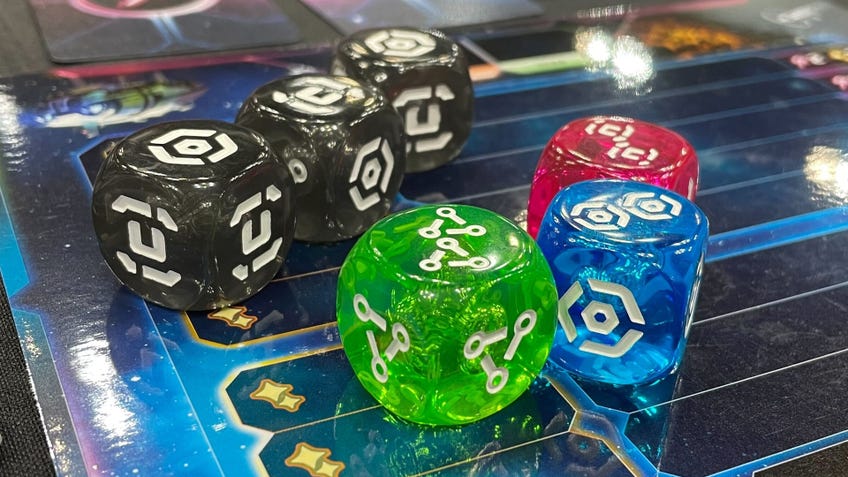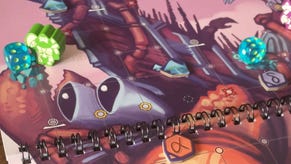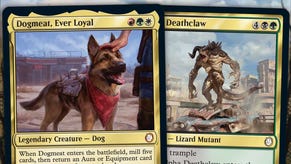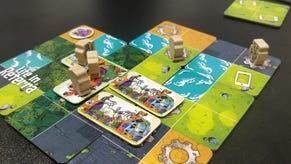Twilight Imperium roll-and-write game Twilight Inscription shrinks the sci-fi classic's length, but not its depth
4-etch.
In the 25 years since Twilight Imperium first crashed onto tables, the sci-fi strategy icon has come to define the idea of an epic board game.
Even in its most recent Fourth Edition, sessions of Twilight Imperium are infamous for stretching from a handful of hours - a fairly brisk playthrough - into the double digits, with some players dedicating an entire day to building up their spacefaring factions, battling over planets and the solar system’s political core in pursuit of galactic supremacy.
Twilight Imperium’s imposing length combines with a fairly steep climb up its rules for newcomers - expect to add at least a couple of extra hours for teaching first time around - and enough cardboard tiles and plastic spaceships to leave most tables creaking. In short, it’s a board game that asks a lot of you.
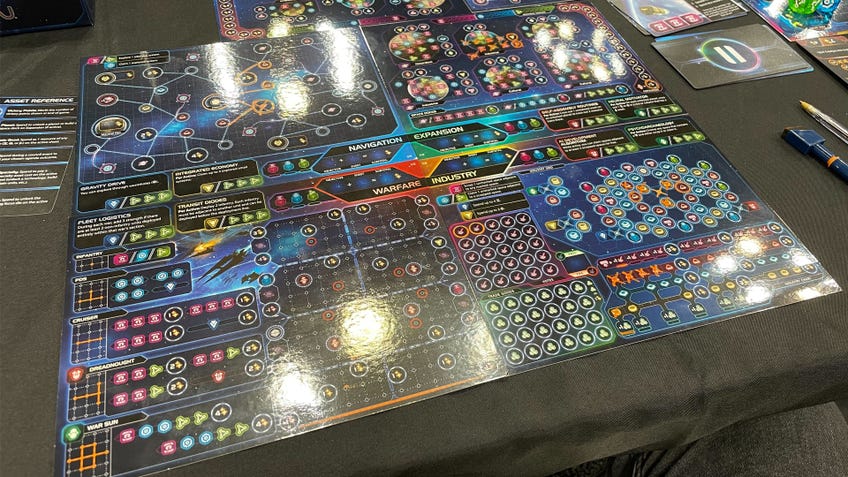
If you can gather a group big enough to populate the table-spanning galaxy and block out a time to play, that investment pays off handsomely. Twilight Imperium is a rich buffet of on-the-board strategy and round-the-table player interaction, combining the vast of 4X strategy - in which players explore the universe, expand their faction’s reach, exploit planetary resources and exterminate their rivals through intense space battles - with the social diplomacy of trade and political machinations. A quarter of a century and many, many sci-fi board games later, there’s still nothing quite like it.
Twilight Inscription manages to bring the best elements of its disparate halves together in a deep, thoughtful adaptation.
With epic scale as central to Twilight Imperium as Mecatol Rex, the announcement of a roll-and-write spin-off, Twilight Inscription, earlier this year raised some eyebrows. It was the meeting of opposites, a tabletop oxymoron: the hobby’s biggest, longest game meeting a genre largely defined by light, quick experiences.
Having played a guided demo of Twilight Inscription at Gen Con 2022 ahead of its release later this year, my experience of the unexpected collision was that of a game that manages to bring the best elements of its disparate halves together in a deep, thoughtful adaptation.

Let’s answer the obvious up front: Twilight Inscription is a far, far shorter game than Twilight Imperium, aiming to clock in at under two hours compared to its evening-eating sibling. Our demo lasted around 30 minutes, but the advantages of making the game a roll-and-write were clear: like many roll-and-writes, players perform their actions simultaneously on personal sheets, eliminating the wait for your next turn and keeping Twilight Inscription’s playtime fairly consistent, even with a full table of eight players.
If squeezing the whole of Twilight Imperium onto a single side of A4 sounds like an impossible task, you’d be right. Players don’t just have one fillable sheet in front of them, but four, representing the key gameplay ingredients of the game - which also loosely align the four Xs of the 4X genre.
On the navigation sheet, players draw lines across a galactic map, circling connected resources and planets to collect and capture them. These planets can be used on the expansion sheet to unlock grids of symbols, which can then be crossed out by spending matching icons, earning bonuses for completed rows and columns. The industry sheet allows players to collect additional resources from a hex grid, with the choice to immediately claim resources or instead scrap spaces - permanently losing the symbol to access more valuable resources further out.
While players largely stay in their own neck of the galaxy when exploring, collecting and producing, the fourth sheet, warfare, primes the table for an explosive confrontation. Players construct military units and ships - flattened into Tetris-like dot and line patterns - in each of eight gridded segments. The wall of grids is stacked four blocks high, with each storey triggered by a successive war event from a central event deck. The left and ride columns divide to attack each player’s neighbours, with the victor claiming points.
Meanwhile, Twilight Imperium’s political clashes become agenda cards, divisive events affecting the entire table or even specific factions that players can sway in their favour by using gathered votes. Like the board game, seizing the galactic seat of Mecatol Rex grants a significant bonus in the form of both votes and victory points, with the bonus reduced for each successive player that reaches the planet.
Twilight Inscription is by some distance the most complex and lengthy roll-and-write game I’ve ever played.
Twilight Inscription isn’t just a roll-and-write, but also a flip-and-write, with an event card revealed at the beginning of each round to determine specific effects and a set of symbols available for each player to spend on a sheet. Players can activate a different sheet from their opponents and even use resources banked on other sheets in front of them to add to their turn, but only use a single sheet each turn.
Once the event card has been resolved, the dice come in. A central pool of delightfully chunky translucent cubes are rolled, handing all players the same three symbols - plus potential bonus symbols, if they unlock three colourful dice in later rounds - to spend.
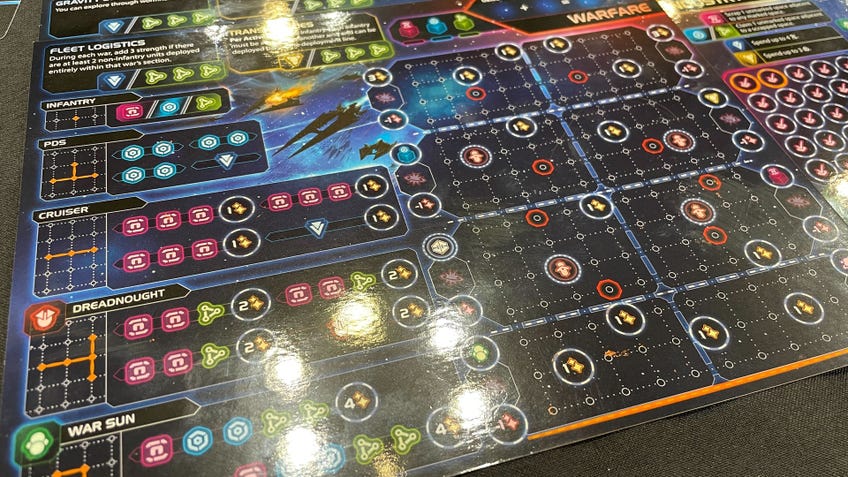
Phew. Frankly, there’s a lot in Twilight Inscription to keep track of - and like its bigger counterpart, the sheer number of symbols, text blocks and differing gameplay rules can be overwhelming to absorb upfront. But Twilight Inscription’s roll-and-write shell does ultimately make it surprisingly digestible once you grasp the language of its icons and the fairly neat structure of each turn: you reveal a card, use the matching symbols on one sheet, roll the dice, use the symbols on the same sheet, repeat. While each sheet is almost its own minigame, they share a common set of symbols and you only need to understand one at a time. Need a planet? Set off into space to find one. Have a planet? Expand your population and production power. Lacking resources? Claim some from the planets you’ve taken. Been a while since a war event happened? Probably time to bulk up your space fleet.
After spending half an hour digesting Twilight Inscription’s meaty basics, one thing was clear: any worries that the roll-and-write would be a shallow imitation of Twilight Imperium can be dispelled. Twilight Inscription is by some distance the most complex and lengthy roll-and-write game I’ve ever played, and - while it’s understandably not quite as deep as the board game - doesn’t skimp at all on the potential for rewarding strategy and hard-fought competition.
The first half of our demo was spent simply wrapping my head around its remoulding of Twilight Imperium into four sheets and some dice, with the second half spent excited to see what I could do with the basics under my belt.

There’ll be no shortage of room to experiment too, with Twilight Inscription including all of the factions from both Twilight Imperium: Fourth Edition and its expansion, Prophecy of Kings. Each faction comes with its own unique ability, a faithful translation of those seen in the original board game to the roll-and-write format. If that wasn’t enough of a way to shake things up from game to game, all four of the sheets have different A and B sides, which can be combined in any format - and with players able to use completely unique combinations in the same session, it looks to offer a huge amount of replayability and variation without changing the central gameplay.
Most importantly, Twilight Inscription manages to achieve the impossible, bringing together two things that seem utterly incompatible and creating something brand new for both. It feels like a true Twilight Imperium game in its vast depth and width, but with the trimmed focus and (relatively) pacey modesty of a roll-and-write game. As a fan of both, I came away itching to play more - and with the hope that I might actually be able to find the time and people more regularly than once a decade.
If Twilight Imperium helped define epic board gaming a quarter-century ago, Twilight Inscription may well help define a new age of epic roll-and-writes. Let’s see what the next 25 years hold. That’s enough time for at least a couple plays, right?
